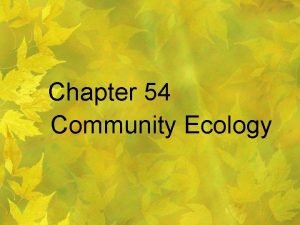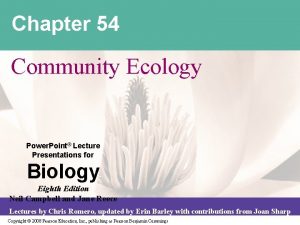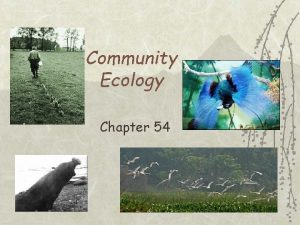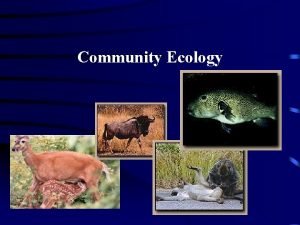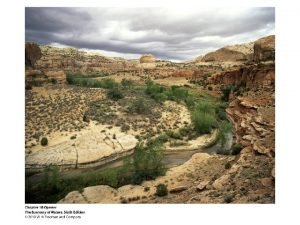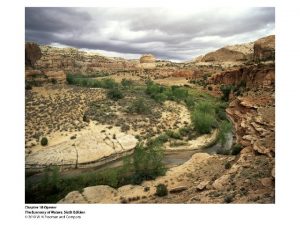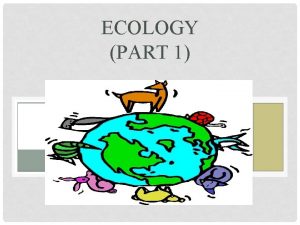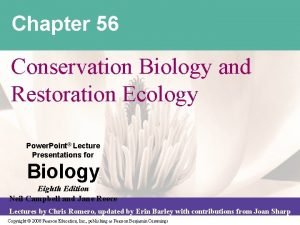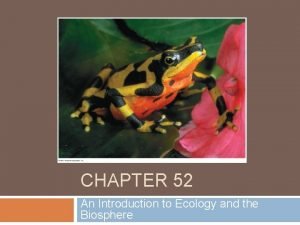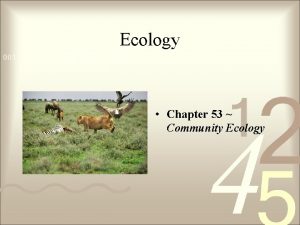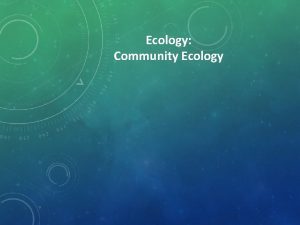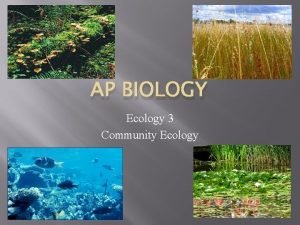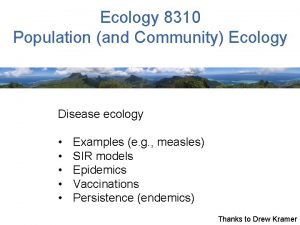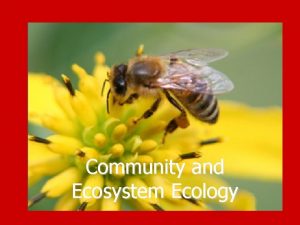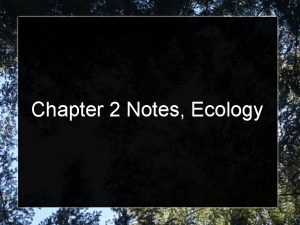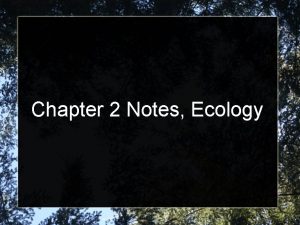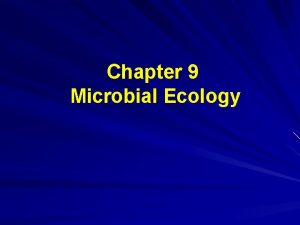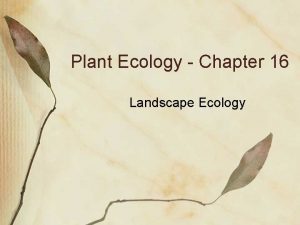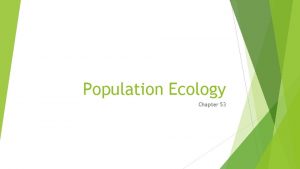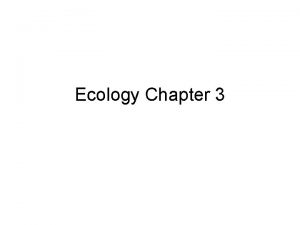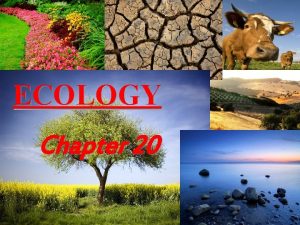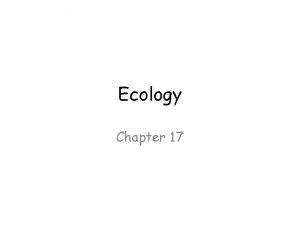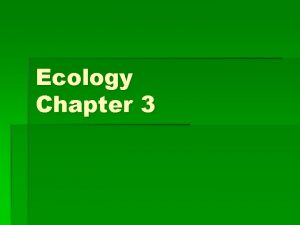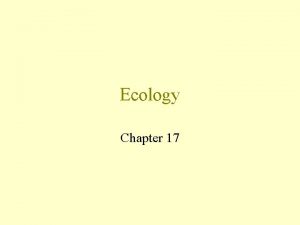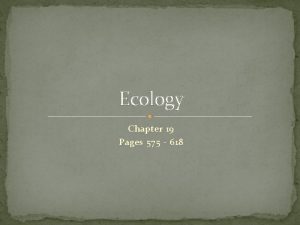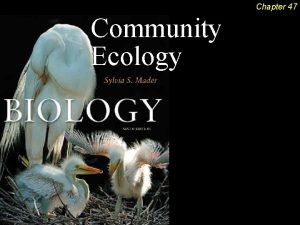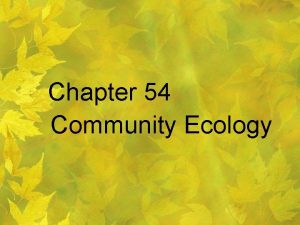Chapter 54 Community Ecology Community structure Community group

























- Slides: 25

Chapter 54 ~ Community Ecology

Community structure Community = group of populations of different species living close enough to interact Richness (number of different species) and Abundance (each species numbers in a community) determine the Species Diversity of a community

Interactions Interspecific = interactions between populations of different species within a community Intraspecific = interactions within the same species

Interactions Competition = (-/-) interactions that occurs when individuals of different species compete for a resource that limits the growth and survival of each species

Competition Competitive Exclusion Principle = 2 species with similar needs for the same limiting resources cannot coexist in the same place Gause experiment

Competition evidence Resource partitioning sympatric (same location) species consume slightly different foods or use other resources in slightly different ways Ex: 7 Anolis lizard species perching sites in the Dominican Republic Character displacement sympatric species tend to diverge in those characteristics that overlap Ex: Darwin’s finch beak size on the Galapagos Islands

Niche Ecological niche = the sum of an organism’s use of biotic and abiotic resources in its environment; its “ecological role” Fundamental = the set of resources a population is theoretically capable of using under ideal conditions Realized = the resources a population actually uses Thus, 2 species cannot coexist in a community if their niches are identical Ex: Barnacle sp. on the coast of Scotland

Interactions Predation = (+/-) interaction between species in which one species, the predator, kills and eats the other, the prey May involve a keystone species/predator

Predation defense Cryptic coloration (camouflage) Aposematic coloration - (warning) Mimicry- superficial resemblance to another species

Mimicry Batesian= palatable/ harmless species mimics an unpalatable/ harmful model Mullerian= 2 or more unpalatable, aposematically colored species resemble each other

Interactions Herbivory = (+/-) interaction in which an organism eats parts of a plant or algae. Plants can’t run away to avoid being eaten, so they have adaptations that help: toxins, spines, thorns

Interactions Symbiotic Relationships Parasitism = (+/-) interaction in which one organism, the parasite, derives it nourishment from another organism, its host, which is harmed in the process

Symbioitic Relationships Mutualism = (+/+) interactions in which both species benefit Commensalism

Symbioitic Relationships Commensalism = (+/0) interaction between species that benefits one of the species but neither harms nor helps the other

Species Impact on Community Structure �Dominant species = highest amount of biomass (sum weight of all the members of a population) and most abundant �Keystone species = exert control on community structure; if removed, they have a large impact on food web and might even cause the collapse of the ecosystem � Effects on the ecosystem are disproportionate relative to their abundance � Examples: sea otter, dragonfly, gray wolf, elk, starfish


How the Wolves Changed Rivers Video

Species Impact on Community Structure �Species diversity – number of different species in a community and relative abundance of each �Trophic structure – feeding relationships of organisms � Food chains and webs

Evapotranspiration relates to the amount of water evaporation from soil and plants What relationship can you conclude from this graph about the water availability in an area compared to species richness?

Species Impact on Community Structure Invasive species = organisms (typically introduced by humans) that take hold outside their native range May not face the natural predators and agents of disease that would otherwise hold their populations at check ▪ Ex: Kudzu

Succession �Ecological succession = transition in species composition over ecological time �Process of predictable and sequential rebuilding of the ecosystem

Succession Video �Primary = begun in lifeless area where soil is not present �Ex: volcanic activity, retreating glacier, sand dune formation, forest on Stone Mountain �Secondary= an existing community has been cleared by some disturbance that leaves the soil intact �Forest fires, flooding

Succession �Primary succession Pioneer species – first organisms to inhabit a barren area ▪ Ex: mosses and lichen Climax community – final stable community �Secondary succession Ex: fires in Yellowstone National Park in 1988

Blowout after a storm and dunes will be rebuilt

Biogeographic factors Community diversity dependent on: Latitude of community: plant and animal life generally more abundant in the tropics, becoming less so moving toward poles Area of community: the larger the geographic area, the more species the community has Islands – isolation and limited size contributes to community diversity Rates of immigration and extinction influenced by size of island distance from mainland
 Chapter 3 section 1 community ecology
Chapter 3 section 1 community ecology Chapter 54: community ecology answer key
Chapter 54: community ecology answer key 5 evolution and community ecology
5 evolution and community ecology Chapter 54 community ecology
Chapter 54 community ecology Chapter 5 evolution and community ecology
Chapter 5 evolution and community ecology Ecosystems interactions
Ecosystems interactions Chapter 54 community ecology
Chapter 54 community ecology Chapter 4 section 1 population dynamics answer key
Chapter 4 section 1 population dynamics answer key Population vs community ecology
Population vs community ecology Population vs community ecology
Population vs community ecology Community ecology
Community ecology Definition of community ecology
Definition of community ecology The definition of community
The definition of community Community ecology
Community ecology Levels of organization ecosystem
Levels of organization ecosystem Marine ecology
Marine ecology Chapter 56 conservation biology and restoration ecology
Chapter 56 conservation biology and restoration ecology Phosphorus cycle pearson education
Phosphorus cycle pearson education Chapter 53 population ecology
Chapter 53 population ecology Chapter 52 an introduction to ecology and the biosphere
Chapter 52 an introduction to ecology and the biosphere Equilibrial life history
Equilibrial life history Section 1 organisms and their relationships
Section 1 organisms and their relationships Chapter 2 principles of ecology test answers
Chapter 2 principles of ecology test answers Principles of ecology chapter 2 section 1 answer key
Principles of ecology chapter 2 section 1 answer key Chapter 4 population ecology answer key
Chapter 4 population ecology answer key Chapter 53 population ecology
Chapter 53 population ecology

